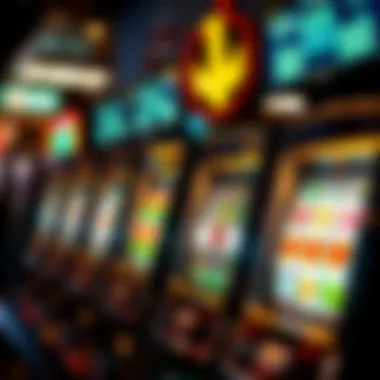Understanding Cash Machine Slot RTP in Gambling


Intro
In the realm of gambling, understanding the mechanics behind cash machine slot Return to Player (RTP) is crucial for seasoned players and novices alike. RTP serves as a guiding star, illuminating the odds of winning when one plays in a casino. When diving into the world of cash machines, often referred to as slot machines, players should comprehend not just how they function but also how RTP affects their potential returns over time.
The concept of RTP is straightforward yet profoundly influential. It indicates the percentage of all wagered money a slot machine is programmed to return to players over an extended period. For instance, a machine with a 95% RTP theoretically returns $95 for every $100 gambled, taking the other $5 as profit. But don’t let these numbers fool you. The actual return one might experience in a gaming session can dramatically differ. Variability in gameplay, bet sizes, and even sheer luck means no player can expect to walk away with a consistent return aligned with the RTP.
Grasping how RTP works and its implications can empower players to make informed decisions about which machines to engage with. It fosters not just a better understanding of the gambling experience but also aids in crafting strategies that may enhance one’s odds in this stochastic environment.
As we navigate through this article, we will dissect aspects surrounding RTP, explore betting techniques, and delve into practical insights that resonate with both casual gamblers and the more analytically-minded poker enthusiasts. Let's roll up our sleeves and delve into the intricacies of these cash machines.
Intro to Cash Machines in Gambling
In the realm of modern gambling, cash machines—often referred to as slot machines or fruit machines—stand as the emblem of chance and thrill. These devices have evolved significantly, not only capturing the attention of players but also serving as a goldmine for casino revenues. In this section, we will explore their significance, delving into the factors making them a pivotal aspect of the gambling industry.
Cash machines are more than just mechanical devices that spit out coins. They embody an intricate system wherein players wager their money in hopes of a favorable return. The ultimate allure of these machines lies in their randomness and unpredictability, creating a unique gambling experience. Furthermore, understanding the mechanics behind their operation, particularly the Return to Player (RTP) concept, enhances player strategy and game selection.
Defining Cash Machines
Cash machines, commonly known as slot machines, are electronic gaming devices that allow players to gamble by inserting money, pulling a lever, or pushing a button. Each machine displays various symbols or numbers that spin and stop randomly, determining the outcome of each play.


- Mechanics: At the core of these machines are complex algorithms that dictate the outcomes, often described as random number generators (RNG). This technology ensures fairness and unpredictability, forming the backbone of each gaming session.
- Types of Machines: There are multiple variants, including classic three-reel slots, video slots with immersive graphics, and progressive jackpot machines where the payout potential can skyrocket with each play. Each type caters to varying player preferences, be it nostalgia or modern gaming experiences.
The Evolution of Cash Machines
Cash machines have undergone a remarkable transformation since their inception. What began as simple mechanical devices has now burgeoned into sophisticated digital platforms.
- Historical Context: Early machines, like the Liberty Bell, were simplistic, with limited payout potential. As technology advanced, so too did the complexity and engagement levels of these machines. The shift from mechanical levers to digital interfaces opened the floodgates for innovative gameplay.
- Current Trends: Today's slot machines boast stunning graphics, animations, and themed experiences based on popular culture. Features like bonus rounds and free spins further engage players, driving higher revenues. Moreover, the introduction of online cash machines has expanded the gaming landscape, breaking geographical barriers and allowing access from the comfort of home.
Understanding the evolution of cash machines is crucial for players and operators alike. It highlights how the player experience has been shaped by technological advancements and changing consumer preferences. As we delve deeper into the intricacies of Return to Player (RTP) in the following sections, it becomes apparent how these factors intertwine to influence the gaming landscape.
Exploring Return to Player (RTP)
The concept of Return to Player (RTP) stands at the core of understanding both the mechanics and appeal of cash machine slots. This is not just another statistic thrown at players; it serves as a compass guiding gamblers through the often murky waters of gambling expectations. When it comes to cash machines, knowing the RTP can greatly enhance one's grip on their own gaming strategies. For gamblers, being equipped with this knowledge can make the difference between a casual player and one who seeks to optimize their outcomes.
What is RTP?
RTP, or Return to Player, is a term that encapsulates the percentage of wagered money that a machine, over time, pays back to players. For instance, if a slot machine has an RTP of 95%, it means that for every $100 played, the machine is designed to return $95 back to players in winnings over the long haul. This figure doesn’t guarantee that every player will win back their money; rather, it operates as an average across many plays. For the savvy player, RTP becomes a vital metric. It can aid in decision-making when selecting which particular slot to play.
It's important to note however that RTP can vary considerably between machines, which can confuse players new to gambling. Higher RTP values tend to indicate better chances of winning, however, they aren't the only factor to consider; volatility and gameplay style also play crucial roles in the overall experience. Some machines may boast a high RTP but could also entail greater risk and variance than others, which makes understanding RTP far from simplistic.
RTP in Context


Placing RTP into context is like fitting together pieces of a puzzle. One must consider not only the RTP value itself but also a myriad of factors including house edge, volatility, and player behavior. House edge, the advantage the casino holds over players, tends to be inversely related to RTP. The higher the RTP, the lower the house edge. But don’t be fooled – this is merely one component in the broader gambling landscape.
Moreover, RTP varies based on specific themes and gameplay mechanics. For example, a classic fruit machine often has a different RTP when compared to a video slot laden with bonus rounds and sophisticated graphics. Furthermore, the player’s knowledge and style significantly influence their gaming experience.
When thinking of RTP, players might want to consider how it fits within their budget and gameplay preferences. Engaging in slots with higher RTP typically aligns more with a strategic, long-term approach to gaming. It could mean the difference between contentment and frustration, especially after a string of losses or unexpected wins. Essentially, RTP is a lens through which a player can examine their overall gambling experience.
"RTP is not just about what the machine returns; it’s about how you, as a player, interpret and leverage that information in your game strategy."
Importance of RTP in Cash Machine Slots
Return to Player, or RTP, is a fundamental element in the realm of cash machines, often influencing player choices and gaming experiences. Understanding RTP is vital for both seasoned gamblers and newcomers alike, as it represents the percentage of wagered money a game is designed to return to players over time. This figure serves as a guide, informing players not just about their potential winnings but also about their statistical odds of success.
How RTP Affects Gameplay
The RTP can shape the entire gameplay experience in cash machine slots. When players are aware of a slot’s RTP, it can alter their expectations and strategies. For instance, if a slot boasts an RTP of 96%, players intuitively grasp they stand to gain a decent return compared to those with an RTP of 85%. This understanding can motivate players to choose higher RTP slots, potentially leading to increased satisfaction and engagement during play.
Moreover, RTP can influence the frequency of payouts. Games with a higher RTP tend to offer more frequent, albeit smaller, wins, while lower RTP slots might tantalize with larger jackpots but are less predictable in terms of wins. Thus, understanding RTP helps players align their playing style with their goals—whether they're after steady small wins or are willing to risk it all for a big score.
In essence, a keen awareness of how RTP functions can dramatically enhance a player's strategic approach. It could mean the difference between a casual player who may not consider RTP in their decision-making and a savvy gambler who meticulously selects machines based on their RTP statistics.
Comparative Analysis of RTP in Different Slots


The variation in RTP across different cash machine slots is notable and warrants attention. Slots can cater to different player preferences and budgets, influenced greatly by their RTP. For example, popular game titles such as Starburst and Book of Ra are known for their above-average RTP ratings which often encourage players to return.
However, this doesn't mean that lower RTP games are not worth a try. Players often are drawn to their unique themes or gameplay mechanics that might compensate for a seemingly less favorable RTP.
Here’s a brief overview to showcase this diversity:
- High RTP Slots: These typically range from 96% to 99%, such as Mega Joker and Blood Suckers. They often draw players looking for better odds.
- Medium RTP Slots: These might present RTP values between 91% and 95%, like Gonzo’s Quest. They're a popular choice for those looking to balance risk and potential rewards.
- Low RTP Slots: Games like Dragon's Luck with RTP below 90% may promise larger win potentials, targeting risk-takers fascinated by the thrill of gambling.
Understanding the distinctions in RTP not only aids in making informed choices but can also enhance the enjoyment of gameplay. It encourages players to explore and compare their options, leading to a richer gambling experience.
In summary, RTP is more than just a statistic; it's a guiding principle that dictates the flow of cash machine slot enjoyment and overall player outcomes. The importance of RTP cannot be overstated—it's key to understanding how to navigate the world of gambling effectively.
Calculating RTP for Cash Machines
Calculating the Return to Player (RTP) for cash machines is not just a mere mathematical exercise; it's a fundamental component that shapes the entire gambling experience. Understanding how RTP is calculated allows players to make more informed decisions. A deep dive into RTP calculations reveals how it influences both gameplay and the strategic choices of players who frequent cash machines.
Mathematics Behind RTP
RTP is expressed as a percentage, representing the portion of all wagered money that a game is programmed to pay back to players over time. The formula to calculate RTP is relatively straightforward, though its implications are anything but simple. Here’s a basic rundown of how RTP is typically calculated:
- Total Wagered Amount: This is the sum of all bets placed by players in a specific timeframe.
- Total Payouts: This includes all winnings a cash machine has dispensed during that same timeframe.
- RTP Calculation: The RTP percentage can be calculated using the formula:RTP (%) = (Total Payouts / Total Wagered Amount) x 100
For instance, if players wagered a total of $1,000,000 over a year and the machine returned $950,000 to them, the RTP would be calculated as follows:
RTP = ($950,000 / $1,000,000) x 100 = 95%















